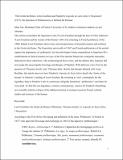Files in this item
The Grotte du Renne, Leroi-Gourhan and Flaubert's Légende de Saint Julien l’Hospitalier (1877): : the question of 'préhistoire(s)' to delimit the human
Item metadata
| dc.contributor.author | Orr, Mary Margaret | |
| dc.date.accessioned | 2021-09-30T15:30:02Z | |
| dc.date.available | 2021-09-30T15:30:02Z | |
| dc.date.issued | 2021-11-01 | |
| dc.identifier | 273718856 | |
| dc.identifier | b921a568-11c4-4d48-8eb7-043875edba84 | |
| dc.identifier | 000698621500004 | |
| dc.identifier | 85116212078 | |
| dc.identifier.citation | Orr , M M 2021 , ' The Grotte du Renne, Leroi-Gourhan and Flaubert's Légende de Saint Julien l’Hospitalier (1877): the question of 'préhistoire(s)' to delimit the human ' , Paragraph , vol. 44 , no. 3 , pp. 334-348 . https://doi.org/10.3366/para.2021.0374 | en |
| dc.identifier.issn | 0264-8334 | |
| dc.identifier.other | ORCID: /0000-0002-3485-5088/work/100901593 | |
| dc.identifier.uri | https://hdl.handle.net/10023/24067 | |
| dc.description.abstract | This article reconsiders the important work of Leroi-Gourhan through the lens of Chris Johnson's ‘Leroi-Gourhan and the Limits of the Human’ (2011) by returning to the context of French prehistory of the 1860s that lies behind Leroi-Gourhan's discoveries and interpretations of hominid remains and artefacts in the Grotte du Renne. The Exposition universelle of 1867 and French publications of the period capture the importance of ‘préhistoire’ for Second Empire France materialized in Napoleon III’s establishment at Saint-Germain-en-Laye of the first national Musée des Antiquités nationales dedicated to their collections. The archaeological discoveries, and the debates they inspired, did not escape the encyclopedic bricolage and designs of Flaubert. With delicious clins d'oeil to the question of ‘l'homme fossile’ and ‘l’homme futur’ that he had already debated with Louis Bouilhet, this article uncovers how Flaubert's Légende de Saint Julien details the ‘limits of the human’ in Johnson’s reading of Leroi-Gourhan. By returning to ‘real’ counterparts for the legendary Stag in Flaubert’s tale, its contextual, allegedly fantastical, ‘préhistoires’ can better be excavated. To find the non-legendary, extreme contemporary, sources for Flaubert's disturbing text crucially informs critique of the dehistoricization of seeing in postwar French cultural studies and sciences of the human. | |
| dc.format.extent | 15 | |
| dc.format.extent | 324289 | |
| dc.language.iso | eng | |
| dc.relation.ispartof | Paragraph | en |
| dc.subject | Leroi-Gourhan | en |
| dc.subject | Grotte du Renne | en |
| dc.subject | Préhistoire | en |
| dc.subject | L'home fossile | en |
| dc.subject | La Légende de Saint Julien l'Hospitalier | en |
| dc.subject | PQ Romance literatures | en |
| dc.subject | DC France | en |
| dc.subject | T-NDAS | en |
| dc.subject | MCC | en |
| dc.subject.lcc | PQ | en |
| dc.subject.lcc | DC | en |
| dc.title | The Grotte du Renne, Leroi-Gourhan and Flaubert's Légende de Saint Julien l’Hospitalier (1877): : the question of 'préhistoire(s)' to delimit the human | en |
| dc.type | Journal article | en |
| dc.contributor.institution | University of St Andrews. French | en |
| dc.identifier.doi | https://doi.org/10.3366/para.2021.0374 | |
| dc.description.status | Peer reviewed | en |
| dc.identifier.url | https://www.euppublishing.com/toc/para/44/3 | en |
This item appears in the following Collection(s)
Items in the St Andrews Research Repository are protected by copyright, with all rights reserved, unless otherwise indicated.

